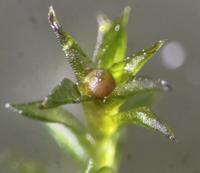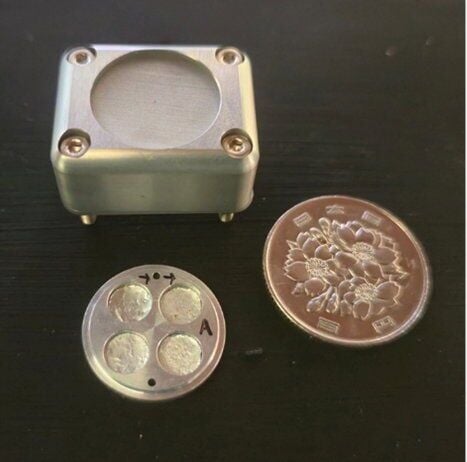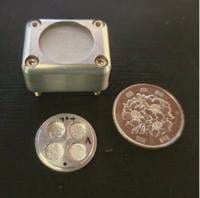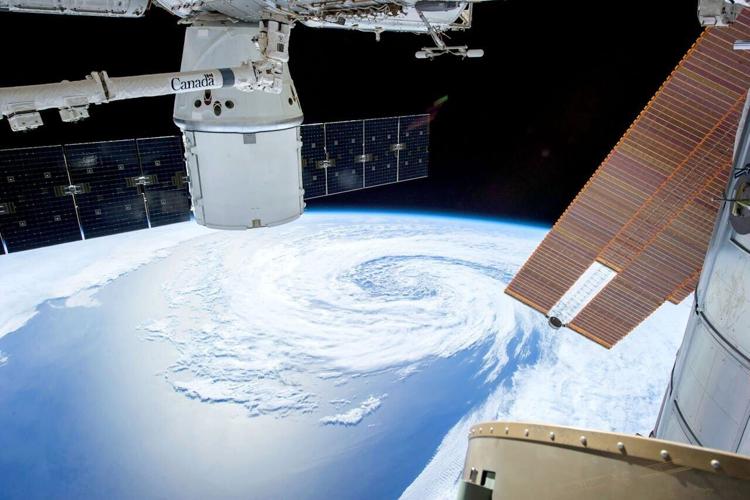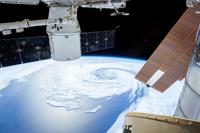
A reddish-brown sporophyte can be seen at the top center of a leafy gametophore. This capsule contains numerous spores inside. (Tomomichi Fujita via SWNS)
By Stephen Beech
Moss has survived nine months exposed to outer space.
The simple plant continued to thrive in the vacuum of space during an experiment conducted on the exposure facility of the International Space Station (ISS).
The moss even made it back to Earth after 283 days - still capable of reproducing.
And scientists calculated that the spores could have survived for up to 5,600 days - around 15 years - in space.
The ground-breaking experiment is the first time it has been shown that a land plant can survive long-term exposed to the elements of space.
The research team hope their findings help towards developing ecosystems in extraterrestrial environments, such as on the Moon or Mars.
Mosses thrive in the most extreme environments on Earth, including the peaks of the Himalayas, the baking sands of Death Valley, the Antarctic tundra and the lava fields of active volcanoes.
Inspired by moss’s resilience, researchers sent moss sporophytes - reproductive structures that encase spores - to the most extreme environment of space.
The findings, published in the journal iScience, show that over 80% of the spores survived nine months outside of the ISS and made it back to Earth still capable of reproducing.

Germinated moss spores after space exposure. (Dr. Chang-hyun Maeng and Maika K via SWNS)
Study lead author Professor Tomomichi Fujita, of Hokkaido University in Japan, said: “Most living organisms, including humans, cannot survive even briefly in the vacuum of space.
"However, the moss spores retained their vitality after nine months of direct exposure.
"This provides striking evidence that the life that has evolved on Earth possesses, at the cellular level, intrinsic mechanisms to endure the conditions of space.”
The concept of space moss occurred to Fujita while studying plant evolution and development.
He was struck by moss’s ability to colonise even Earth's harshest environments.
Fujita said: “I began to wonder: could this small yet remarkably robust plant also survive in space?”
To find out, he subjected Physcomitrium patens, a well-studied moss commonly known as spreading earthmoss, to a simulated space environment, including high levels of UV radiation, extreme high and low temperatures, and vacuum conditions.
The research team tested three different structures from the moss - protenemata, or juvenile moss; brood cells, or specialized stem cells that emerge under stress conditions; and sporophytes, or encapsulated spores - to find out which had the best chance of surviving in space.
Fujita said: “We anticipated that the combined stresses of space, including vacuum, cosmic radiation, extreme temperature fluctuations, and microgravity, would cause far greater damage than any single stress alone."
The research team found that UV radiation was the toughest element to survive, and the sporophytes were by far the most resilient of the three moss parts.
None of the juvenile moss survived high UV levels or extreme temperatures.

The space exposure unit used for the experiment is next to a 100-yen coin for scale. Moss has survived nine months exposed to outer space. (Tomomichi Fujita via SWNS)
The brood cells had a higher rate of survival, but the enclosed spores exhibited around a thousand times more tolerance to UV radiation.
The spores were also able to survive and germinate after being exposed to −196°C for over a week, as well as after living in 55°C heat for a month.
The researchers suggested that the structure surrounding the spore serves as a protective barrier, absorbing UV radiation and blanketing the inner spore both physically and chemically to prevent damage.
The team noted that it is likely an evolutionary adaptation that allowed bryophytes - the group of plants to which mosses belong - to transition from aquatic to terrestrial plants 500 million years ago and survive several mass extinction events since then.
To see if the adaptation could make the sporophytes fit for the actual conditions of space, the team sent the spores beyond the stratosphere.
In March 2022, the researchers sent hundreds of sporophytes to the ISS aboard the Cygnus NG-17 spacecraft.
Once they arrived, the astronauts attached the sporophyte samples to the outside of the ISS, where they were exposed to space for a total of 283 days.
The moss then hitched a ride back to Earth on SpaceX CRS-16 in January 2023 before being returned to the lab for testing.
Fujita said: “We expected almost zero survival, but the result was the opposite: most of the spores survived.

(Photo by SpaceX via Pexels)
“We were genuinely astonished by the extraordinary durability of these tiny plant cells.”
More than 80% of the spores survived their intergalactic journey, and all but 11% of the remaining spores were able to germinate back in the lab.
The team also tested the chlorophyll levels of the spores and found normal levels for all types, with the exception of a 20% reduction in chlorophyll a - a compound which is particularly sensitive to changes in visual light, but this change didn’t seem to impact the health of the spores.
Fujita said: "This study demonstrates the astonishing resilience of life that originated on Earth."
Curious how much longer the spores could have survived in space, Fujita’s team used the data from before and after the moss’s expedition to create a mathematical model.
They predicted that the enclosed spores could have survived for up to 5,600 days under space conditions.
However, the team emphasized that this number is just a rough estimate and that significantly more data is needed to make more realistic predictions.
They hope that their work helps advance research on the potential of extraterrestrial soils for facilitating plant growth.
Fujita added: "Ultimately, we hope this work opens a new frontier toward constructing ecosystems in extraterrestrial environments such as the Moon and Mars.
“I hope that our moss research will serve as a starting point.”




